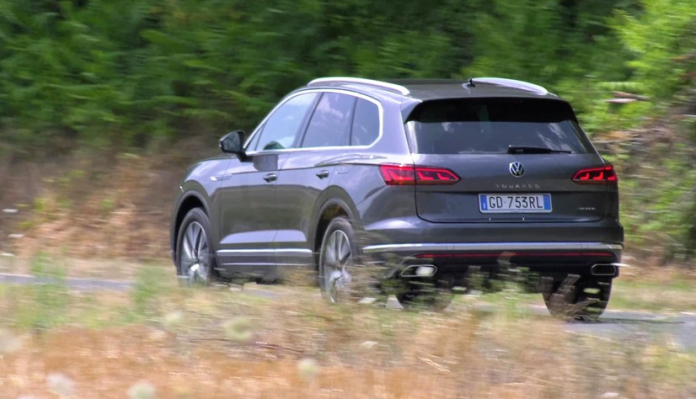The test is dedicated to Volkswagen’s flagship: once the Phaeton retired (does anyone remember the hyper-technological sedan?), the Touareg became the flagship model of the German brand.
Today more and more customers prefer large SUVs to classic flagships and then, with the latest generation, it has become more technological and luxurious, taking a decisive step forward in terms of quality, equipment and safety.
The test is dedicated to the plug-in hybrid version, the eHybrid.
DESIGN AND DIMENSIONS
Ever since it came out its design divides: especially for the massive front. Following a bit the new stylistic course of the brand is rather aggressive but for sure it is unmistakable.
Looking at it from the side, despite being longer than the previous generation (by almost 8 cm), it turns out to be well proportioned, with a much more streamlined design, and they managed to lighten the side with the upper rib; even the rather inclined rear window increases its momentum. Behind them they dared less and it seems to me more successful and balanced; someone might even remember his cousin Audi.
The dimensions: length 4,878 mm x width 1,984 mm x height 1,702 mm, with a wheelbase of 2,894 mm. It is longer but also wider than before, so compared to the previous generation inside it promises more space for the lucky passengers and for luggage.
HABITABILITY AND INTERIOR
If outside it can divide, inside it puts everyone in agreement or almost: it is difficult to remain indifferent to the large high-resolution curved digital display entirely covered in glass that merges the 12.3″ digital instrumentation with the screen of the 15″ navigation system. A total area of 27″, facing the driver: they call it innovision Cockpit.
The cockpit has a design with few frills. Seats and finishes with precise and accurate assemblies and processing, quality materials, definitely up to expectations, considering the target to which it is addressed. The Touareg is spacious, comfortable and very practical: five adults, even tall, are comfortable; the third passenger, however, will have to stay with his legs a little widened due to the large central tunnel.
Despite being lower than before, there is plenty of head and leg room. They made this choice, giving up the possibility of offering the optional seven seats, which instead is found on other competitors. However, it boasts a rather wide opening of the rear doors, so as to make it easier to install the seats for the little ones.
The capacity of the trunk is reduced a little: in the normal versions it ranges from 810 to 1800 liters. In the plug-in hybrid, between battery and cables, we are at 665 and 1655. Among the options you can choose the pack that includes the air suspension: you can thus lower the load plan, to make things easier with heavy or bulky objects.
SHEET
Engine: Plug-In Hybrid / 6 Cylinders – Otto Cycle
Displacement: 2.995 cc
Maximum heat engine power: 250 kW / 340 hp
Maximum torque thermal engine: 450 Nm 1.340 – 5.300 rpm
Maximum electric motor power: 100 kW / 136 hp
Combined maximum system power: 280 kW / 381 hp
Maximum combined system torque: 600 Nm
Exhaust emission class: Euro 6d-ISC-FCM
Gearbox: Tiptronic 8-speed
Battery Type: Li-ion
Battery capacity: 17.9 kWh
Charging time in alternating current at 2.3 kW: 08h 30′
Charging time in alternating current at 3.6 kW: 05h 10′
Charging time in alternating current at 7.2 kW: 02h 30′
Combined fuel consumption: 2,7 – 2,9 l/100km
Emissions: 61 g/km1
Combined power consumption: 242.2 – 246.6 Wh/km
Mass in running order: 2.352 kg
Tank capacity: approx. 76 l
Tires: 285/45 R20
Max speed: 250 km/h
Acceleration 0-100 km/h: 6,3 s
ROAD TEST
The Touareg eHybrid is equipped with an electric motor and a 3.0 TSI petrol V6 with 340 hp (250 kW), which it shares with its cousin Audi Q7. When the lithium-ion battery is nicely charged, it can count on an overall system power of 280 kW (381 hp) with a torque of up to 600 Nm.
Volkswagen claims that the battery capacity is 17.9 kWh and allows a range in electric mode of up to 47 km. I immediately wanted to carry out a test in the city to verify what was promised.
After recharging 14.73 KWh in 2 hours and 44 minutes (unfortunately the Touareg does not allow you to make fast recharges in direct current), I started the test by opting for the E-Mode mode and the Eco driving profile, the one aimed at reducing consumption.
I faced the entire city route using only the battery-powered electric motor: D gearbox, automatic climate on 21 °, in the city around 12 o’clock, normal traffic of that hour, outside temperature between 28 ° and 30 °.
I covered 39 km, much better than many others that sometimes stop halfway through the declared distance. I detected an average consumption of 0.5 liters of fuel per 100 km and 30.8 kWh per 100 km. To be precise, the heat engine intervened on two occasions when I accelerated more decisively. But you don’t need it: with a thread of gas the heavy SUV moves with great fluidity, in absolute silence.
Never forget that the real range varies according to various factors such as: personal driving style, road conditions, outside temperature, heating or air conditioning and more.
Once recharged again, the test became more “normal”, choosing the Hybrid mode, in which the system optimizes the use of the electric and thermal motor. The driving position is excellent: wide seats, electrically adjustable, heated, and great visibility.
The new Touareg was built on the MLB Evo platform, which it shares with some models from Audi, Bentley Bentayga, Porsche Cayenne and Lamborghini Urus but, especially compared to the last two, you will find that Volkswagen has prioritized comfort over driving fun. It is now larger but lighter: with the extensive use of aluminum, high-tech steels and a complete redesign, it has lost about a hundred pounds (106 to be precise) compared to before. However, we are always at an altitude of 2352 kg.
The ride comfort that the Touareg can offer is truly remarkable, it is quiet, responsive, with an 8-speed automatic transmission, rather fluid when you are in city traffic, at low speeds it changes gears smoothly. When you choose the Sport mode and you want to give it a little inside, if you accelerate decisively in climbing the Tiptronic (which in the video I absent-mindedly called DSG, sorry …) is not as fast as it should be.
Speaking of comfort, I vote ten to the 4-zone automatic climate Air Care Climatronic, with the controls also rear: it is very effective, it managed to make us travel in the cool even on the hottest days of July. And it is not so obvious: there are cars of a certain level that do not succeed in the same way.
The city is certainly not its ideal habitat: it still puts you at ease, offers good visibility everywhere but it is long, and above all very wide. In cities where there are very narrow streets in the center, it becomes a bit challenging; in paid public parking lots you have to pay close attention because often you just pass without doing damage. Not to mention the normal parking areas: I hope that for future ones they will decide to make larger individual spaces. Cars have grown, even the smallest Panda is much larger than its mythical ancestor, and SUVs and Crossovers today are in increasingly higher percentages.
































